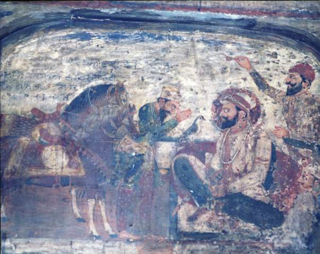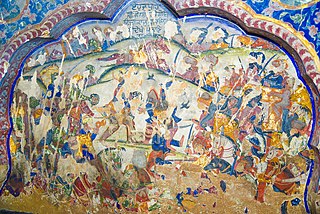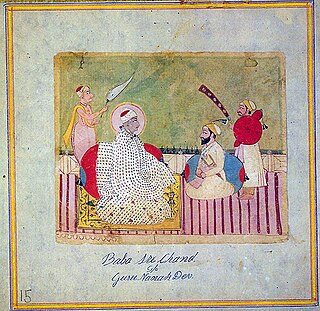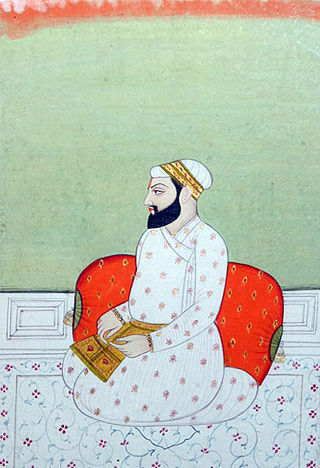
Guru Har Rai revered as the seventh Nanak, was the seventh of ten Gurus of the Sikh religion. He became the Sikh leader at age 14, on 3 March 1644, after the death of his grandfather and the sixth Sikh leader Guru Hargobind. He guided the Sikhs for about seventeen years, till his death at age 31.

The Nishan Sahib, also known as the Sikh flag, is used to represent the Sikh people worldwide. In 1936, the Shiromani Gurdwara Parbandhak Committee ratified the Sikh Rehet Maryada, which states its colour as either basanti (xanthic) or surmai. It is a triangular flag with a Khanda in its centre, made of cotton or silk cloth, and has a tassel at its end.

Baba Gurditta was the son of Guru Hargobind, and the father of Guru Har Rai of Sikhism. There is a gurudwara in Kiratpur Sahib, Punjab which is in remembrance of Baba Gurditta.
Dal Khalsa was the name of the combined military forces of 11 Sikh misls that operated in the 18th century (1748–1799) in the Punjab region. It was established by Nawab Kapur Singh in late 1740s.

Goindwal, also known as Goindwal Sahib and alternatively transliterated as Goindval, is located in the Taran Taran district of the Majha region of Punjab, India about 23 km (14 mi) from Tarn Taran Sahib. In the 16th century it became an important center for the Sikh religion during the Guruship of the Guru Amar Das Ji. Goindwal is on the banks of the Beas River and is one of the focal points of small scale industries of Tarn Taran district.

Mata Gujri, also spelt as Mata Gujari, was the wife of Guru Tegh Bahadur, the ninth Guru of Sikhism, and the mother of Guru Gobind Singh, the tenth Guru of Sikhism. She played a central role in the history of Sikhism and is one of the four consorts bestowed with the title of Guru-Mahal.

Bhai Gurdas was a Sikh writer, historian and preacher who served as the Jathedar of the Akal Takht from 1606 to his death in 1636. He was the original scribe of the early version of Guru Granth Sahib, having served as the amanuensis of Guru Arjan in its compilation.

Bidhi ChandChhina was a Sikh religious preacher and military commander, from Chhina Bidhi Chand village, 37 kilometers south of Amritsar and Chhina Bidhi Chand was part of Amritsar District not Lahore. His birth place temple is situated in his own village Chhina Bidhi Chand, which was built by the residents with the help of Baba Daya Singh. Baba Daya Singh laid foundation with his own hands. Every year on his birthday Baba Daya Singh, and now Baba Avtar Singh, would go to village Chhina Bidhi Chand and celebrate it there to date. He was a disciple of Guru Arjan and served Guru Hargobind for most of his life.

Guru Ram Das, sometimes spelled as Guru Ramdas, was the fourth of the ten Sikh gurus. He was born to a family based in Lahore, who named him Bhai Jetha. He was orphaned at age seven; and thereafter grew up with his maternal grandmother in a village.

Bandi Chhor Divas, also known as Bandi Chhor Dihara, is a Sikh celebration commemorating the day when the sixth Guru of Sikhs, Guru Hargobind, and 52 Hindu kings were released from Gwalior Fort, who had been imprisoned by Mughal Emperor Jahangir. Emperor Jahangir had held 52 Kings at the Gwalior Fort for several months. Gurdwara Data Bandi Chhor Sahib is located at the place of the Guru's internment in the Fort. The day falls in autumn and often overlaps with Hindu Diwali, the festival of lights celebrated across Punjab and the rest of India. Historically, from the time of the third Sikh Guru Amar Das, Sikhs and Hindus of the time used the occasion of Diwali, Vaisakhi and other such festivals to congregate at the seat of the Gurus. In 2003, Sikh religious leaders and the Shiromani Gurdwara Parbandhak Committee led by Prof. Kirpal Singh Badungar formally adopted this day into the Nanakshahi calendar.

The Battle of Kartarpur occurred on 25 April 1635. It started when the Mughal Empire attacked the town of Kartarpur. The Mughal force was repulsed by the Sikh defenders. The battle occurred in the locality of Kartarpur in present-day Jalandhar district of Indian Punjab.

Sri Chand, also referred to as Baba Sri Chandra or Bhagwan Sri Chandra, was the founder of the Udasi sect of ascetic Sadhus. Sikh sources give his life the impressive dates of 8 September 1494 – 13 January 1629, which would have made him 134 years old upon his death.

Guru Arjan was the fifth of the ten total Sikh Gurus. He compiled the first official edition of the Sikh scripture called the Adi Granth, which later expanded into the Guru Granth Sahib. He is regarded as the first of the two Gurus martyred in the Sikh faith.

The Mīnās were a heretical sect of Sikhs that followed Prithi Chand, the eldest son of Guru Ram Das, after his younger brother Guru Arjan was selected by the Guru to succeed him. Prithi Chand would vigorously contest this, attracting a portion of Sikhs to his side who followers of Guru Arjan referred to as ਮੀਣੇ mīṇe, meaning "charlatans," "dissemblers," or "scoundrels." They sustained their opposition to the orthodox line of Gurus through the seventeenth century, and upon Guru Gobind Singh's founding of the Khalsa in 1699, they were declared by him, as well as by Khalsa rahitnamas, as one of the Panj Mel, or five reprobate groups, that a Sikh must avoid. They are occasionally referred to in the more neutral terms Sikhān dā chhotā mel or as the Miharvān sampraday in scholarship.

Baba Buddha was a prime figure in early Sikhism.

The Jathedar of the Akal Takht is the head of the Akal Takht and head of the Sikhs worldwide. The jathedar has the de facto power as the supreme spokesperson of the Khalsa to summon, trial and sentence any person who identifies as a Sikh from the Akal Takht.

Prithi Chand, also spelt as Prithia, was the eldest son of Guru Ram Das – the fourth Guru of Sikhism, and the eldest brother of Guru Arjan – the fifth Guru. He founded the heretical Mina sect of Sikhism. Prithia based his movement out of Heir village, located in present-day Lahore district in Punjab, Pakistan.

Chandu Shah is a man who features in Sikh historical accounts. Sikh tradition holds that he was an affluent banker and revenue official of the Mughal emperors from Lahore who conspired against the fifth Sikh guru, Guru Arjan.

The Akāl Sena was the Sikh military force established by the sixth Sikh Guru, Guru Hargobind. It was the first standing Sikh army. It was also known as the Akali Dal.




























